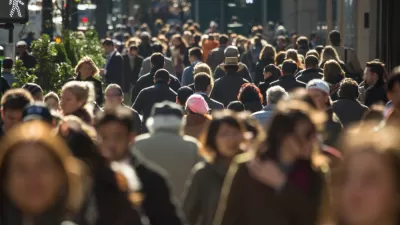Births and birth rates dropped to a 30-year low, not an issue of concern yet, but if the trend continues, the U.S. could join other developed nations that must deal with the consequences of an aging population. Immigration plays an uncertain factor.
"The birth rate fell for nearly every group of women of reproductive age in the U.S. in 2017, reflecting a sharp drop that saw the fewest newborns since 1987, according to a new report [pdf] by the Centers for Disease Control and Prevention, reports Bill Chappell for NPR on May 17.
There were 3,853,472 births in the U.S. in 2017 — "down 2 percent from 2016 and the lowest number in 30 years," the CDC said.
That was the largest drop in a single year since 2010, states PBS correspondent Amna Nawaz on the NewsHour (video and transcript available) on May 17. "Last year, the only group to see a higher birth rate was women in their 40s. All this amid some concerns about America’s aging population."
"[T[his report is big news," states Dr. Hans-Peter Kohler, a social and economic demographer at the University of Pennsylvania.
The really surprising part is that we have now been quite some years through the [Great Recession], and unemployment rate is very low, and that trend hasn’t changed. So these low fertility rates, despite relatively good economic conditions, are really surprising.
“Every year I look at data and expect it will be the year that birthrates start to tick up, and every year we hit another all-time low,” said Kenneth M. Johnson, a demographer at the University of New Hampshire, reports Sabrina Tavernise for The New York Times on May 16. “It’s one of the big demographic mysteries of recent times.”
Fertility rate continues dropping
"The general fertility rate sank to a record low of 60.2 births per 1,000 women between the ages of 15 and 44 — a 3 percent drop from 2016, the CDC said in its tally of provisional data for the year," writes Chappell.
Last year's post on vital statistics, "Another Problem to Blame on Millennials," listed total, as opposed to general, fertility rates for 2016 as "1,818.0 births per 1,000 women, a decrease of one percent from 2015, and the lowest since 1984. Chappell notes last year's decrease:
The CDC calculates a "total fertility rate" by estimating how many babies a hypothetical group of 1,000 women would likely have over their lifetime. That measure now stands at 1,764.5 births per 1,000 women — a 3 percent drop from 2016. The replacement rate is 2,100 births per 1,000 women.
However, it's been below the replacement rate since 1971. Last year's drop, as with the birth rate, "was the largest single-year decline since 2010," the CDC said. The fertility rate has been in decline since 2007, "when the U.S. finally broke its post-World War baby boom record, with more than 4.3 million births," adds Chappell. A 2013 post indicated that fertility rates had stabilized, but that didn't last long.
Live births and general fertility rates in the United States are graphed from 1970–2016 on page one of the report [pdf] from CDC's National Center for Health Statistics. The 2017 data is shown, but it is provisional.
Role of immigration
The numbers seem to correspond with what the Census Bureau and others [dated May 2013] have been predicting for years: America's population growth will increasingly depend on immigrants, after decades in which the U.S. enjoyed a relatively high fertility rate when compared with that of other developed countries.
"Foreign-born Americans and their descendants have been the main driver of U.S. population growth, as well as of national racial and ethnic change, since passage of the 1965 law that rewrote national immigration policy," according to a Pew Research Center report dated Sept. 28, 2015. "They also will be the central force in U.S. population growth and change over the next 50 years."
However, Kohler states during the PBS interview that immigration was not a big factor in the CDC's findings.
[I]mmigrant fertility adjusts relatively quickly to the U.S. native fertility. And I don’t think changes in immigration policy or immigration flows had a big contribution to these recent declines in total fertility rates.
Does it matter?
Kohler gives two reasons: More children born in a developed country is "an indicator of the well-being of the adult population, from the notion that individuals who are satisfied with their life and have relatively good economic prospects are more likely to have children."
The other reason we care about this is that children born today are obviously the workers 25 years down the road and are retirees some 60, 70 years down the road...So, in the long term, if this trend persists, they’re going to have profound implications. And the annual number of birth probably has relatively small implications.
He adds that if "total fertility rates drop to rates like 1.2 in many Southern European countries [and] South Korea, and somewhat higher levels in Japan," at some point policymakers must consider "the kind of implications of rapidly aging populations and possibly declining labor force that become very difficult to manage through social policies."
FULL STORY: U.S. Births Dip To 30-Year Low; Fertility Rate Sinks Further Below Replacement Level

Alabama: Trump Terminates Settlements for Black Communities Harmed By Raw Sewage
Trump deemed the landmark civil rights agreement “illegal DEI and environmental justice policy.”

Planetizen Federal Action Tracker
A weekly monitor of how Trump’s orders and actions are impacting planners and planning in America.

The 120 Year Old Tiny Home Villages That Sheltered San Francisco’s Earthquake Refugees
More than a century ago, San Francisco mobilized to house thousands of residents displaced by the 1906 earthquake. Could their strategy offer a model for the present?

In Both Crashes and Crime, Public Transportation is Far Safer than Driving
Contrary to popular assumptions, public transportation has far lower crash and crime rates than automobile travel. For safer communities, improve and encourage transit travel.

Report: Zoning Reforms Should Complement Nashville’s Ambitious Transit Plan
Without reform, restrictive zoning codes will limit the impact of the city’s planned transit expansion and could exclude some of the residents who depend on transit the most.

Judge Orders Release of Frozen IRA, IIJA Funding
The decision is a victory for environmental groups who charged that freezing funds for critical infrastructure and disaster response programs caused “real and irreparable harm” to communities.
Urban Design for Planners 1: Software Tools
This six-course series explores essential urban design concepts using open source software and equips planners with the tools they need to participate fully in the urban design process.
Planning for Universal Design
Learn the tools for implementing Universal Design in planning regulations.
Clanton & Associates, Inc.
Jessamine County Fiscal Court
Institute for Housing and Urban Development Studies (IHS)
City of Grandview
Harvard GSD Executive Education
Toledo-Lucas County Plan Commissions
Salt Lake City
NYU Wagner Graduate School of Public Service




























